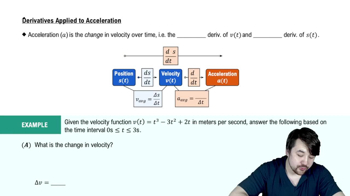{Use of Tech} A damped oscillator The displacement of a mass on a spring suspended from the ceiling is given by .
a. Graph the displacement function.
 Verified step by step guidance
Verified step by step guidance Verified video answer for a similar problem:
Verified video answer for a similar problem:



 6:29m
6:29mMaster Derivatives Applied To Velocity with a bite sized video explanation from Patrick
Start learning